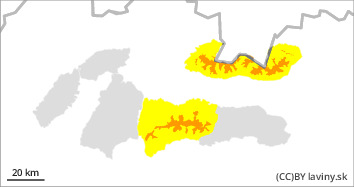
Danger level
 | treeline |
|  |
|  | ||||
|  |  |

High winds with significant precipitation will cause unstable slabs of wind-drifted snow that are deposited on hard ground.
In the Western, High and Western part of the Low Tatras there is an increased avalanche danger above the forest boundary, i.e. the 3rd degree. The main avalanche problem remains wind-blown snow. Strong north-westerly winds, which reached 160 km/h in gusts on Thursday. It has created particularly on the leeward sides under the rock walls and in narrow couloirs wind-beaten slabs, which are deposited on the hard snow cover. These layers are not well interconnected at all. Especially the leeward SE, E, NE and SW orientations will be particularly dangerous. Avalanche release will therefore be possible with only a small additional load; in addition, spontaneous avalanches of medium size may occur during the day. The second avalanche problem is the new snow, which is mainly made up of loose hailstones on hard ground. All exposures are dangerous.
Snowpack
In the last 24 hours the most snow fell in the Western Tatras up to 30cm. It is very unevenly distributed and blown to the windward sides of the ridges under the glass walls or into the forest zone. The ridges of the mountains and the windward sides are blown into the hard and sometimes rocky subsoil. At higher elevations, due to cooler temperatures, the snow is drier and is mainly made up of hailstones, which will form a dangerous layer in the coming days. As the altitude drops, the new snow becomes wetter and becomes soaked through to the hard ground. Despite today's snowfall, the snow cover is well below average at altitudes up to 1200 m above sea level.
Tendency
Significantly rising due to strong winds and expected precipitation.
Compiled By : Pavel Beťko



